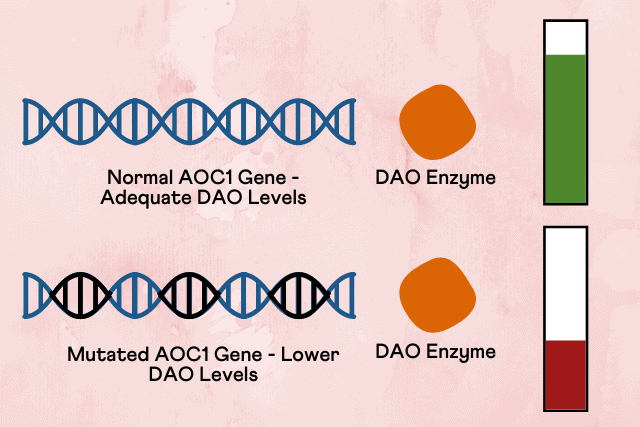Histamine Intolerance: The What and Why.
Histamine is a chemical released in the body to counter allergies.
High levels of this chemical in the bloodstream can cause discomfort.
Some people are more prone to histamine intolerance due to genetic causes.
What Is Histamine?
Histamine is a chemical that protects the body from specific allergens.
It is released in the blood when common allergens like pollen and mold enter the body.
Histamine also plays an essential role in digestion.
It signals the brain to release stomach acids.
Histamine is an important chemical that safeguards the body against allergies.
However, too much of it in the body can cause uncomfortable symptoms like a runny and congested nose.
Most people can easily break down too much histamine.
But some people have genetic reasons that prevent them from adequately digesting histamine.
High Histamine Symptoms. How Can You Tell You Are Intolerant?
Histamine intolerance symptoms are challenging to diagnose, even by medical professionals.
In addition, these symptoms overlap with many other conditions and disorders.
However, you can still look out for these symptoms:
- Chronic and persistent headaches
- Painful menstruation (dysmenorrhea)
- The nasal mucus and asthma attacks
- Red and watery eyes
- Flaky and red skin
- Welts and bumps on the skin
What Foods Are High In Histamine?
It is challenging to exclude certain foods based on their histamine secretion-inducing property.
However, fermented or highly processed foods might cause a problem if you are histamine intolerant.
These foods can be eliminated from your diet and then added back gradually.
- Fermented foods: Certain fermented foods can cause allergy symptoms.
Sauerkraut is a type of fermented cabbage dish eaten in Germany.
It increases allergy symptoms in the body.
- Alcohol: People who are histamine intolerant are often alcohol intolerant as well.
Histamine reacts with sulfites present in edible alcohol.
Therefore, migraines are often a result of alcohol intolerance.
- Processed meat: Packaged meat is often said to cause a histamine spike in the body.
The cooking method, too, changes the meat’s qualities.
For example, boiled meat is less of an allergen than grilled meat.
- Aged cheese: Cheese stored at a higher temperature is more allergy-inducing than those held at a lower temperature.
- Legumes: Kidney beans and chickpeas can cause problems for asthma patients.
These legumes can irritate the mucous membrane of the nose and trigger histamine secretion.
Genetics of Histamine Intolerance
Some people cannot metabolize histamine in their bodies.
This could be due to changes in specific genes.
Histamine is metabolized by two enzymes: diamine oxidase (DAO) and histamine N-methyltransferase (HNMT).
In some people, the genes that contain instructions for producing these enzymes have certain changes in them.
This can lead to lower enzyme levels or enzymes with defective activity.
When this happens, histamine is not broken down effectively.
As a result, histamine build-up occurs, giving rise to all the symptoms.
Is There A Genetic Test For Histamine Intolerance?
A genetic test may not be able to diagnose histamine intolerance.
However, it can help identify your risk for this condition.
The test analyzes the genes responsible for producing enzymes that break down histamine to detect any changes.
The test results are used to arrive at a score based on which your risk for histamine intolerance can be identified.
Did You Know? You Can Use Your Ancestry Test DNA Data To Get This Report. Find Out How!
How Much Histamine is Too Much?
The average histamine level in the blood is 0.3-1.0 ng/mL.
Anything above that can cause histamine intolerance.
Above 1-2 ng/mL, heart rate and stomach acid secretion increase.
Above 3-5 ng/mL, flushing, headaches, and skin itching can happen.
Once the histamine levels are above 100 ng/mL, it can cause a heart attack.
Eating foods high in histamine can also have adverse effects on the body.
For example, eating rotten fish can lead to severe vibrations and blocking of airways.
Tolerant vs. Intolerant People
Different levels of histamine might trigger tolerant and sensitive individuals.
75 mg of liquid histamine can cause allergy symptoms in healthy people.
But histamine intolerant people can be triggered by a much lower amount than that.
For example, canned sardines can trigger a histamine reaction at a lower threshold in sensitive people.
How Does A Histamine Intolerance Diet Look Like?
A histamine intolerance diet would mean limiting the consumption of certain foods.
Most fermented foods tend to trigger a histamine reaction.
Eating fresh meat, cooked egg yolk, and plant-based milk is ideal for sensitive people.
Most fresh fruits can also be eaten, except citrus fruits like strawberries.
Summary: High Histamine Symptoms
Histamine is a chemical that shields the body from allergens.
But too much of it can cause adverse effects and problems.
Most healthy individuals can break down histamine naturally in their bodies.
However, people sensitive to histamine can have an overload of this chemical.
It can cause mild symptoms like nasal congestion to severe symptoms like heart block.
Certain foods can cause high histamine levels in the body, and sensitive people should avoid their consumption.
Histamine-intolerant people should eat fresh fruits, meat, and vegetables.





